|
Yacht Builders - Early Adopters
 ecause of the highly competitive
nature of yacht racing, whether at the club, national, or international
levels, the yachting fraternity almost zealously embraces advances in
small craft design and technology. Yacht builders and owners rush to
incorporate new equipment, materials, and ideas. They act as enthusiastic,
unofficial research and development partners. Commercial- or fishing-boat
builders and operators are slower to adopt these same advantages. They use
their vessels for business and must maintain complete reliability and trust.
New fastenings, such as ring nails; new shapes like the deep Vee or planing
hulls; or, in earlier times, the gaff-free Bermuda or the Marconi sailing
rigs, were all found in recreational craft before fishing vessels. Not least
among these technical changes was the adoption of glass reinforced plastic
(GRP), more commonly called "fibreglass". The pleasure craft fraternity
embraced fibreglass for sail and power boats in the late 1940s, and almost
universally converted to the new material on both sides of the Atlantic by
the mid-1950s. ecause of the highly competitive
nature of yacht racing, whether at the club, national, or international
levels, the yachting fraternity almost zealously embraces advances in
small craft design and technology. Yacht builders and owners rush to
incorporate new equipment, materials, and ideas. They act as enthusiastic,
unofficial research and development partners. Commercial- or fishing-boat
builders and operators are slower to adopt these same advantages. They use
their vessels for business and must maintain complete reliability and trust.
New fastenings, such as ring nails; new shapes like the deep Vee or planing
hulls; or, in earlier times, the gaff-free Bermuda or the Marconi sailing
rigs, were all found in recreational craft before fishing vessels. Not least
among these technical changes was the adoption of glass reinforced plastic
(GRP), more commonly called "fibreglass". The pleasure craft fraternity
embraced fibreglass for sail and power boats in the late 1940s, and almost
universally converted to the new material on both sides of the Atlantic by
the mid-1950s.
|
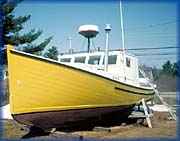
|

Colourful Cape Islander
Gale, a classic Cape Island boat, at rest for the winter near Chester
Basin, Nova Scotia. This boat was built at Vogler's Cove, Nova Scotia
in 1964, and her bright colours are typical of the genre.
(Courtesy: David Walker)
|
|
New Materials in the Fishery
 n 1961, Nova Scotia started to
explore and promote the advantages of the new material in the fishery.
The Nova Scotia Department of Industrial Development commissioned the
building of a fibreglass inshore fishing boat. A contract was awarded to
the Atlantic Bridge Company of Lunenburg. The new Cape Island style boat
was designed by William Hines of the Department of Fisheries and was
christened Cape Islander when it was completed in 1962. The Nova Scotia
Department of Fisheries demonstrated the boat throughout the inshore
fishery, allowing fishermen to use the vessel in selected areas, under
varied conditions, and using various fishing technologies. n 1961, Nova Scotia started to
explore and promote the advantages of the new material in the fishery.
The Nova Scotia Department of Industrial Development commissioned the
building of a fibreglass inshore fishing boat. A contract was awarded to
the Atlantic Bridge Company of Lunenburg. The new Cape Island style boat
was designed by William Hines of the Department of Fisheries and was
christened Cape Islander when it was completed in 1962. The Nova Scotia
Department of Fisheries demonstrated the boat throughout the inshore
fishery, allowing fishermen to use the vessel in selected areas, under
varied conditions, and using various fishing technologies.
The vessel was not an instant success despite the benefits of the
homogenous leak-free hull, low maintenance costs, and other apparent
advantages. It seems the tradition-minded fishermen were unwilling to
accept the new material. Some said it made alterations to the vessel
difficult to achieve, while others claimed the material was too rigid
and too hard on the legs of men spending longs hours at sea. After some
years as a trial-horse, Cape Islander was retired to the government-owned
Liscomb Lodge for use as a pleasure boat by tourists who wanted to go
fishing. She has since been retired and can be seen in the collection
of the Fisheries Museum of the Atlantic in Lunenburg.
|
|
Fibreglass
 ibreglass boat hulls are built
within a mould just as a jelly is moulded. First a full-sized hull,
called a plug, must be built in the exact form and shape of the desired
finished product. Since the plug is disposable, it can be built from a
variety of materials. When completed, the important exterior surface of the
plug is finished to the desired standard. It is covered with a coating of a
wax-like release agent and a series of layers of fibreglass cloth and
fibreglass matt, a less expensive felt-like material. Each layer is
impregnated with a synthetic polymer resin that cures and hardens. When the
desired thickness is achieved, the exterior of the mould is reinforced and
made rigid and self-supporting. It is then divided at the centreline from
the stemhead to transom cap. The mould is taken apart, and the plug is
removed and discarded. The edges of the division are reinforced to make
them remountable. A boat can now be built within the connected mould after
waxing the interior of the mould, starting with a gel coat. The gel coat
will form the exterior finish of the new hull. After the successive layers
have been built up again and the chemicals have cured, the mould is
separated, and the new hull removed for finishing. ibreglass boat hulls are built
within a mould just as a jelly is moulded. First a full-sized hull,
called a plug, must be built in the exact form and shape of the desired
finished product. Since the plug is disposable, it can be built from a
variety of materials. When completed, the important exterior surface of the
plug is finished to the desired standard. It is covered with a coating of a
wax-like release agent and a series of layers of fibreglass cloth and
fibreglass matt, a less expensive felt-like material. Each layer is
impregnated with a synthetic polymer resin that cures and hardens. When the
desired thickness is achieved, the exterior of the mould is reinforced and
made rigid and self-supporting. It is then divided at the centreline from
the stemhead to transom cap. The mould is taken apart, and the plug is
removed and discarded. The edges of the division are reinforced to make
them remountable. A boat can now be built within the connected mould after
waxing the interior of the mould, starting with a gel coat. The gel coat
will form the exterior finish of the new hull. After the successive layers
have been built up again and the chemicals have cured, the mould is
separated, and the new hull removed for finishing.
|
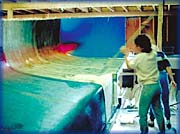
|

Fibreglass Boatyard Workers
Fibreglass boatyard workers rolling resin into fibreglass matt to remove
bubbles and to impregnate the material thoroughly.
(Courtesy: David Walker)
|
|
A newer and more efficient method of producing hulls has almost universally
replaced the hand lay-up of successive layers of impregnated fibreglass
cloth and matt. Materials are now sprayed into the interior of the mould
with a special gun that combines the resin and chopped strands of glass
fibres. Sometimes a combination of the layer and spray methods is used.
|
|
Fibreglass and Wood
 ibreglass boatbuilding is
completely different from traditional wooden boatbuilding because the
materials are completely different. Natural wood has been replaced with
oil-based chemicals and mineral-based glass. There is no direct comparison
between the materials, just as there is no direct comparison between the
finished products. While they may look the same, the wooden boat is built
from scores of interconnected components skillfully assembled by
experienced hands from a carefully selected combination of woods,
fastenings and protective materials. In contrast, the fibreglass hull is
a completely homogenous entity, with no fastenings, openings or transitions
throughout the structure. This means that maintenance is much reduced on the
boats when they are new, although atmospheric elements and sun degrade their
components in time. ibreglass boatbuilding is
completely different from traditional wooden boatbuilding because the
materials are completely different. Natural wood has been replaced with
oil-based chemicals and mineral-based glass. There is no direct comparison
between the materials, just as there is no direct comparison between the
finished products. While they may look the same, the wooden boat is built
from scores of interconnected components skillfully assembled by
experienced hands from a carefully selected combination of woods,
fastenings and protective materials. In contrast, the fibreglass hull is
a completely homogenous entity, with no fastenings, openings or transitions
throughout the structure. This means that maintenance is much reduced on the
boats when they are new, although atmospheric elements and sun degrade their
components in time.
The choice lies between a high-maintenance, traditional, reliable product
and a low-maintenance, longer-lasting boat that most fishermen found more
acceptable despite the fact it was less comfortable on the water. The
homogenous hull is more rigid and does not "give" and flex with the sea
as wooden craft do. In other words, fibreglass boats are less comfortable,
but older fishermen who appreciated the wooden boats are more aware of
this discomfort than younger men who have totally embraced the new
technology.
|
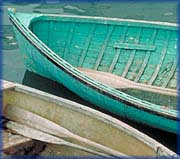
|

Construction Details of a Wooden Boat
The interior of part of a derelict clinker-planked hull, showing the rusted
clench nails which hold the edges of the planks together and attach the
frames to the planking.
(Courtesy: David Walker)
|
|
Commercial Production of Fibreglass Boats Begins
 fter 1962, almost a decade
passed before anyone in Nova Scotia considered building fibreglass boats
commercially. Reginald Ross of Clark's Harbour was a grandson and son of
wooden-boat builders in Clark's Harbour. He launched his first fibreglass
Cape Islander in 1971 and christened her Enterprises. She was 40 feet
long overall, just 8 percent longer than Atlantic Bridge Company's Cape
Islander, but almost 20 percent wider, illustrating the continuing trend
in Cape Island boat design. fter 1962, almost a decade
passed before anyone in Nova Scotia considered building fibreglass boats
commercially. Reginald Ross of Clark's Harbour was a grandson and son of
wooden-boat builders in Clark's Harbour. He launched his first fibreglass
Cape Islander in 1971 and christened her Enterprises. She was 40 feet
long overall, just 8 percent longer than Atlantic Bridge Company's Cape
Islander, but almost 20 percent wider, illustrating the continuing trend
in Cape Island boat design.
Ross built fibreglass fishing boats in quantity in the old Vimy movie
theatre in Clark's Harbour which had been converted for the purpose.
Notably, he hired two local women for part of his production staff. His
first fibreglass boats were small, open-hulled craft, larger but similar
to regional mossing boats. They were fitted with either outboard or
small inboard engines. The small craft were forerunners of larger
vessels, and when they were well received, Ross began to design their
successor. Unlike traditional builders, he drew his design on paper. He
then discussed his plans and the proposed idea with Ernest Atkinson. The
plans of Enterprises can be seen in the Achelaus Smith Museum,
Centreville, Cape Sable Island.
It is not known how Ross built his plug, but, in most cases, a plug was
built like a boat with a supremely well-finished exterior. The plans were
expanded to full size on the floor of the mould loft, and station moulds,
or templates, were built. The templates were erected on a strong,
keel-like back and planked over. There was no framing because the plug
had only to be strong enough to be self-supporting.
Enterprises generated much local interest and, though the new fibreglass
boats were much more expensive than their wooden counterparts, fourteen
examples were built and sold from that first Cape Island hull mould.
Ross' health unfortunately deteriorated, and he died prematurely. The
doors of J.D. Ross Enterprises, the island's first fibreglass boat shop,
closed forever in the mid 1970s.
Reginald Ross had done what the government had not been able to do, and
interest in fibreglass Cape Islander boats rapidly increased. Hulls were
soon being built in Dartmouth, and elsewhere in the province. Freebert
Atkinson began finishing bare fibreglass hulls, following a mainly
shipwright or carpentry process, but using fibreglass cloth and polyester
resin to connect and protect the wooden portions of the structure.
Freebert had gained enough experience by 1977 to start his own fibreglass
boatbuilding shop. He built the hulls and also finished them, but, as his
business increased, he concentrated on moulding hulls for other builders.
|
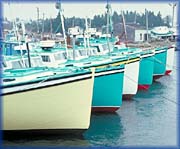
|

Modern Fibreglass Cape Island Boats
Part of the Wedgeport, Yarmouth County fleet of modern fibreglass Cape
Island boats. Note the close similarity among the characteristic high,
straight bows.
(Courtesy: David Walker)
|
|
The rapid acceptance of fibreglass soon eclipsed the wooden boatbuilding
industry. Like Freebert Atkinson, a few wooden boatbuilders retrained
and began manufacturing boats in the new and strange chemical materials.
They made a leap into a technology that was not an adaptation of the old,
but a completely different method of building. Those too slow to make the
transition were soon confronted with empty order books, and they quietly
closed their doors. Occasionally, traditionally minded fishermen decided
to stick with the much-trusted wooden craft and ordered new ones, but
faith in tradition was not enough to sustain the old industry.
A parallel business developed at about the same time, and for a few years
combined the old and new boatbuilding technologies. It was discovered
that a covering of fibreglass cloth and resin over the outside of a
wooden hull could give an old boat extended life, as well as lower
maintenance costs. This enabled less affluent fishermen to obtain some
of the benefits of a fibreglass boat at a much lower cost.
|
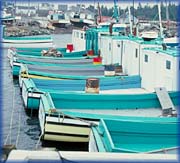
|

Sterns of Modern Fibreglass
Cape Island Boats
The sterns of the same 'raft' of Cape Island boats in Wedgeport.
(Courtesy: David Walker)
|
|
The large, open, working cockpits are now exposed to the transoms, as the
larger hulls allow the compact hydraulic steering gears to be fitted
beneath the soles. The small deck shelters have now been totally enclosed
with sliding doors to make a comfortable, warm, and weathertight
wheelhouse.
|
|
Fibreglass Boatbuilding Dominates
 ibreglass boatbuilding expanded
throughout the province to supply all the requirements for inshore fishing
boats. Builders could be found in every area, but the heaviest concentration
of fibreglass boat shops was to be found on Cape Sable Island where numbers
rose to the extent that chemical and other suppliers were prompted to
establish warehouses there. The new production process meant that operators
had to be trained, and the trend started by Reginald Ross continued: builders
employed increasing numbers of women. They were found in almost every boat
shop, a place where women formerly had rarely been seen, and they were
engaged in boat production. Before the adoption of fibreglass, women
occasionally helped their husbands with the building of wooden boats. More
frequently, they were found keeping the books or doing the paperwork for the
small business. Now they actively moulded hulls - creating the boat. ibreglass boatbuilding expanded
throughout the province to supply all the requirements for inshore fishing
boats. Builders could be found in every area, but the heaviest concentration
of fibreglass boat shops was to be found on Cape Sable Island where numbers
rose to the extent that chemical and other suppliers were prompted to
establish warehouses there. The new production process meant that operators
had to be trained, and the trend started by Reginald Ross continued: builders
employed increasing numbers of women. They were found in almost every boat
shop, a place where women formerly had rarely been seen, and they were
engaged in boat production. Before the adoption of fibreglass, women
occasionally helped their husbands with the building of wooden boats. More
frequently, they were found keeping the books or doing the paperwork for the
small business. Now they actively moulded hulls - creating the boat.
The new material has enabled progressive builders to alter hull shapes and
make changes that were prohibitively expensive or impossible when using wood.
At least one innovative builder devised methods of constructing various sizes
of fibreglass hulls within one convertible mould. Perhaps more significantly,
traditional Cape Island hull shapes have changed only slightly since
fibreglass has been introduced. They are wider, deeper, and have greater
displacement, but essentially all this is done using the basic hull shape that
has remained virtually unchanged for 60 years. The single, most constant
characteristic is the flat aft run of the lines which has endured like a
pedigree from the early power-boat hulls of Atkinson, Kenney and their
followers.
These new hulls are virtually unrecognisable today, however, because they
are hidden under modern enclosed wheelhouses, atop raised forecastles without
cuddies. Some have extended hull platforms for extra capacity without
breaking construction size rules; others have insulated holds under
watertight decks that in turn allow open transoms. With sword-fishing towers
and pulpits at the end of extended bowsprits, some new craft are almost
completely new designs. But their owners and builders still cling proudly to
the "Cape Island Boat" as their title and heritage.
Today fibreglass Cape Island boats completely dominate the inshore fishery.
Whatever their guise, in small, almost traditional, styles used mainly for
lobster fishing or as deep, fat, almost ungainly fishing machines fitted as
seiners, scallop draggers, trawlers, longliners or swordfishermen, they can
be found all along Canada's east coast.
|
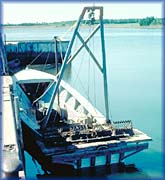
|

Northumberland Strait Boat
This open Northumberland Strait boat has been adapted to drag for scallops.
The steel mesh bags are dragged (towed) along the sandy bottom of the local
waters to scrape the shellfish from their beds. The winch is then used to
haul the scallops to the surface and onto the after shelf to be shucked.
(Courtesy: David Walker)
|
|



